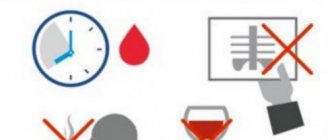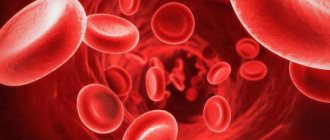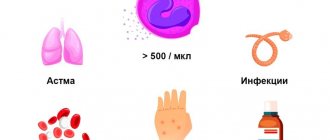Diagnosis of hepatitis Regular preventive examination helps to detect viral hepatitis B at the earliest stages of development. Cost of analysis
Hepatitis B virus Determination of the antigen (HBsAg) of the hepatitis B virus in the blood is an important test for diagnosing hepatitis. More details
Prevention of diseases Some diseases are asymptomatic and can only be detected through laboratory tests. Where can I get tested?
Preventive examination Regular checks of biochemical parameters of the body help to identify various diseases in a timely manner. Where can I get tested?
Tests at home You can take the necessary tests without leaving your home. Call a specialist to your home
Promotions and special offers Special offers and discounts on diagnostic laboratory services allow you to save on medical examinations. View current promotions
HBsAg, or Hepatitis B surface Antigen, is the surface antigen of the hepatitis B virus. It is also called the Australian antigen because it was first discovered in the blood serum of the Australian Aborigines. The disease is detected by the presence and determination of the concentration of HBsAg in the blood using serological, enzyme immunoassays and radioimmunoassays.
Hepatitis and HBsAg
So, the HBsAg antigen is one of the components of the hepatitis B virus (HBV) envelope. In the context of laboratory research, it is a marker (indicator) of the virus[1].
If we talk about the composition of the capsid (virus envelope) of hepatitis B in more detail, it is a complex combination of proteins, glycoproteins, lipoproteins and lipids of cellular origin. HBsAg in this case is responsible for the process of adsorption of the virus by the cell, that is, it ensures the absorption of HBV by hepatocytes - liver cells. Like any other virus, after being introduced into a favorable environment, it begins to replicate (produce) new DNA and proteins necessary for further reproduction (copying) of the virus. Fragments of the virus, in our case HbsAg, enter the bloodstream, through which they spread further.
This is interesting!
HbsAg has amazing resistance to both physical influences (its molecule remains unchanged at temperatures up to 60°C, as well as during cyclic freezing) and chemical influences - the antigen feels great in both extremely acidic environments (2 pH) and alkalis ( 10 pH)[2]. Able to withstand 2% solutions of phenol and chloramine, 0.1% formalin solution, and tolerate urea treatment. Thus, HBV has a very reliable shell for survival in the most unfavorable conditions.
Antigen (antigen) is literally an “antibody producer” (ANTIbody GENerator); it is capable of forming an immunological “antigen-antibody” complex. In other words, it initiates the formation of antibodies in the human body, forming specific immunity that can protect a person from a repeated attack of the virus in the future. This most important feature of HBV is the basis for the production principle of most vaccines containing either “dead” (inactivated) HBsAg or genetically modified antigens that are not capable of leading to infection, but the presence of which is sufficient to form a stable immune response to the hepatitis B virus.
The causative agent of hepatitis B belongs to the hepadnaviridae, the very name of which indicates their connection with the liver (hepa) and DNA (DNA). Thus, HBV is a hepatotropic virus, and the only one among all hepatitis viruses that contains DNA. Its activity (contagiousness and virulence) depends on many factors:
- age (for example, the probability of chronicity of the disease in children under one year of age is 80–90%, under six years of age — 30–50%, in adults — less than 5%)[3];
- individual sensitivity;
- virus strain;
- infectious dose;
- hygienic living and working conditions;
- epidemiological situation.
But in general, the contagiousness of the hepatitis B virus is low, below average, unless you completely neglect all the rules of safe sex life and hygiene.
How is the hepatitis B virus transmitted?
The infection process occurs through blood and biological fluids in the following ways [4]:
- Parenteral, that is, when it enters directly into the blood or mucous membrane, bypassing the body's protective barriers, such as the skin or gastrointestinal tract. Examples of such infection include an unsterile syringe or any surgical instrument.
- Vertical - transplacental, that is, in utero from mother to child, during childbirth, after it.
- Sexual (in all its forms).
- Household, that is, through personal hygiene items (razors, combs, toothbrushes), when applying tattoos, piercings, and so on.
Pathogenesis of hepatitis B
After infection has occurred, an incubation period begins, during which the virus multiplies and accumulates in the body unnoticed. Depending on many factors, the duration of the latent phase of viral replication can vary greatly from case to case, but on average it is 75 days[5].
This is important to know!
HBsAg is the earliest and most reliable serological marker of hepatitis B virus activity. This antigen can be detected even on the 14th day after infection, but most often it is 30–45 days, which also depends on the chosen research method. This diagnostic indicator is also very important because it makes it possible to detect HBV infection sometimes 26 days before, but guaranteed seven days before the appearance of any changes in the biochemistry of blood or urine. The dynamics of the increase in its concentration in the blood serum is similar (proportional) to the change in ALT.
At the end of the incubation period, the so-called prodromal phase of the disease begins, preceding the acute period and foreshadowing it. Then the first signs of the disease appear in the form of general malaise, weakness, fatigue, fever with a temperature on the verge of 37°C, decreased appetite, nausea, bowel disorders, joint and muscle pain, a feeling of tightness and heaviness in the right hypochondrium, irritability and apathy, skin rashes in the area of joints and itching. It should be noted here that all these symptoms can be expressed to varying degrees in different people, be completely absent or go unnoticed. The prodromal, or pre-icteric, period can last from one to 30 days. Its end is indicated by an enlarged liver and spleen, increased urobilinogen in the urine, discoloration of feces, and in the blood serum one can detect an increase in the concentrations of AlAt and AsAt, a decreased content of leukocytes, although in general the leukocyte formula is normal.
Yellowness of the skin and icterus of the sclera (yellow pigmentation of the white membrane of the eyes) mark the entry into the acute phase, or the height of hepatitis B. The increase in the content of total and direct bilirubin in the blood serum increases during the first or second week of the icteric period of the disease, reaching its maximum , after which stagnation and a gradual decline in skin pigmentation occurs until the yellow color disappears completely, which can take up to 180 days or even more.
At the peak points of the disease, in most cases, bradycardia, low blood pressure, and weakening of heart sounds are recorded. In addition, if hepatitis is severe, the following are found:
- depression of the central nervous system;
- pronounced disturbances in the gastrointestinal tract;
- tendency to bleeding in the mucous membranes (prothrombin index is greatly reduced);
- AlAt concentration is higher than AsAt;
- low mercuric acid test, ESR reaction - 2-4 mm/hour, leukopenia;
- lymphocytosis.
After the acute period (not to be confused with the severe form), the disease develops according to one of the following scenarios:
- a period of convalescence (recovery) begins with a gradual decrease (disappearance) of signs of hepatitis B at the clinical, biochemical and morphological levels;
- superinfection in the form of hepatitis D occurs and/or the disease develops into a fulminant form, into the so-called fulminant severe hepatitis (in 1% of cases) [6];
- the disease becomes active chronic:
- a. recovery;
- b. liver cirrhosis and carcinoma (20–30%)[7];
- the disease goes into a state of stable remission (stable chronic form):
- a. cure;
- b. extrahepatic pathologies.
This is important to know!
HBsAg persists throughout the acute stage of hepatitis B. If the antigen is detected in the blood for more than 180 days, it means that the disease has become chronic[8].
From the point of view of the burden on the body, doctors define three main forms of acute hepatitis B: mild, moderate and severe. From the standpoint of the severity of the symptoms of the disease, its icteric (typical), anicteric and subclinical (atypical) forms are distinguished. Typically, the disease proceeds exactly as described above. Most cases occur in atypical forms, when there is no pigmentation of the skin and mucous membranes, and other symptoms are mild (anicteric variant) or when any clinical manifestations are absent at all (subclinical form).
No matter how paradoxical it may sound, in most cases, hepatitis B does not require any special treatment: supportive therapy based on hepatoprotectors, vitamins and microelements, plenty of fluids and a strict diet is sufficient. Of course, the exception is cases with an inherited infection or when there is an immune deficiency (as well as immunosuppressive therapy), concomitant diseases or a severe form of the disease. Otherwise, the human immune system independently copes with the virus within one or two months, acquiring specific immunity. Many people who develop antibodies to the virus claim that they have never had it, when in fact they simply did not notice it or confused it with the regular flu. But the situation is not so successful for all infected people; in addition, no matter in what form a person contracts hepatitis B, there remains an increased risk of developing certain liver pathologies throughout his life.
There is another interesting fact: the so-called asymptomatic antigen carriers[9]. These are not the people who suffered from hepatitis B in a latent, subclinical form - they did not have it at all and do not suffer from it. At the same time, HBsAg carriers remain dangerous to others. Such people act as the main reservoir of infection. This phenomenon has not been studied, but it is likely that the virus itself leaves this category of people “untouched” in order to preserve its population for a rainy day. By what criteria the virus preserves the health of these particular people without causing any harm to their body is unknown. But this is just a hypothesis, and in any asymptomatic carrier the virus can wake up at any minute, or it may never do so.
The diagnostic criteria for asymptomatic carriage are as follows:
- HBsAg antigen is detected in the blood after 180 days;
- the HBeAg marker is not detected in the serum;
- anti-HBe present;
- HBV DNA level in blood serum is less than 105 copies per 1 ml;
- AlAt/AsAt concentrations show normal values during repeated tests;
- during liver biopsy, the histological activity index (MGA) of the inflammatory-necrotic process in the liver is usually below 4.
Hepatitis B markers
As you can see, the serological marker HBsAg is the first, main, most reliable, but far from the only indicator of hepatitis B infection; in addition to it, other antigens, antibodies and viral DNA molecules also require determination in the blood serum (see Table 1).
Table 1. Markers of HBV infection.
| Marker | Marker characteristics | Clinical significance |
| HBeAg | HBV nuclear e antigen, appears in the first week after HBsAg and disappears after 20–45 days | indicates HBV replication in hepatocytes, high virus activity in the blood and a high risk of perinatal transmission of the virus |
| HBcAg | HBV nuclear core antigen | marks HBV replication in hepatocytes, is detected only during morphological examination of liver biopsy specimens and at autopsy, is not detected in free form in the blood |
| anti-HBc (total) (HBc Ab) | total antibodies to HBcAg, detected 7–14 days after HBsAg | an important diagnostic marker, especially with negative results of HBsAg indication, used for retrospective diagnosis of hepatitis B and for unverified hepatitis, HBcAg is determined without division into classes |
| IgM anti-HBc (HBc Ab IgM) | class M antibodies to nuclear antigen , present in the blood from 60 to 540 days | one of the earliest serum markers of hepatitis B, its presence in the blood indicates an acute infection (phase of the disease), in the chronic form it marks HBV replication and the activity of the process in the liver |
| anti-HBe (HBeAb) | antibodies to the e-antigen are found in 90% of patients after 60 days | may indicate the beginning of the convalescence stage (with the exception of the mutant form of HBV) |
| anti-HBs (HBsАb) | protective antibodies to HBV surface antigen | indicate a past infection or the presence of post-vaccination antibodies (their protective titer against HBV infection >10 IU/l); detection of antibodies in the first weeks of hepatitis B predicts the development of a hyperimmune variant of fulminant hepatitis B |
| HBV-DNA | Hepatitis B virus DNA | marker for HBV presence and replication |
The above markers appear and disappear in a certain sequence in accordance with the stages of the disease. Some, such as IgG anti-HBc, remain for life. Only the entire set of markers provides a complete and reliable diagnostic picture. In addition, acute, chronic, fulminant and mixed hepatitis have their own serological profiles (more on this below).
It is impossible not to touch upon such a rare but extremely dangerous phenomenon as parallel infection with hepatitis D (HDV); it can occur in two variants:
- Coinfection, that is, simultaneous infection with hepatitis B and D (delta) viruses, which leads to a much more severe form of the disease, but almost does not become chronic.
- Superinfection, that is, the addition of HDV to a previously “dormant” HBV in the form of an acute severe form or as an exacerbation of the chronic form of hepatitis B. In the latter case, after suppression, it also becomes chronic with a prognosis of cirrhosis or liver cancer.
HDV is a kind of parasite of the hepatitis B virus, its satellite. It cannot replicate in the absence of HBV, since the synthesis of its shell proteins is impossible without the presence of the hepatitis B virus in hepatocytes. Thus, you can get hepatitis B without delta infection, but the other way around will not work. The addition of HDV can cause fulminant hepatitis with the development of acute liver failure and hepatic encephalopathy, which grow rapidly, sometimes leading to death. If the result is positive for the HBsAg antigen, delta infection must be diagnosed. For this purpose, serological markers are used (see Table 2).
Table 2. Markers of HDV infection.
| Marker | Marker characteristics | Clinical significance |
| IgM anti-HDV | class M antibodies to hepatitis D virus | mark HDV replication in the body |
| IgG anti-HDV | class G antibodies to hepatitis D virus | indicate possible HDV infection or previous infection |
| HDAg | hepatitis D virus antigen | marker for the presence of HDV in the body |
| HDV-RNA | Hepatitis D virus RNA | HDV presence and replication marker |
Modern treatment of chronic hepatitis B can stop the disease!
If you are nevertheless diagnosed with chronic hepatitis B, it is necessary to prescribe antiviral treatment, that is, treatment using drugs that can block the replication of the virus.
The goal of modern antiviral therapy for chronic hepatitis B is to persistently suppress the replication of the virus, achieve remission of the disease, that is, transfer the process to an inactive state. When this result is achieved, the development of liver cirrhosis and its complications (such as ascites, internal bleeding, liver failure) is prevented, and the risk of developing liver cancer is greatly reduced.
A number of drugs with antiviral effects are currently registered for the treatment of chronic hepatitis B. Among the new generation of drugs there are safe drugs that can be used for several years, drugs to which the virus does not develop resistance. Your attending physician will help you choose a treatment appropriate to the stage and form of your disease.
Test for the presence of HBsAg in the blood
The analysis can be taken by anyone, but there are certain categories of people for whom such testing is mandatory:
- employees of medical institutions, especially those who work with patients’ blood: manipulation room nurses, gynecologists, surgeons, paramedics, dentists;
- persons with elevated levels of enzymes AsAt and AlAt;
- patients undergoing surgery;
- potential blood donors;
- persons who are carriers of the hepatitis B virus, patients with a chronic form of this disease;
- pregnant women.
In addition, the study is recommended in the presence of symptoms such as nausea, vomiting, loss of appetite, change in the color of urine and feces, jaundice, that is, all those signs of hepatitis B that were described at the beginning of the article. But in general, every person, if they take their health responsibly, should do a serological test for HBsAg once a year.
Today, there are already three generations of methods for serological diagnosis of HBsAg[10], and the most informative and sensitive of them, capable of detecting concentrations up to 0.05 ng/ml, have gradually replaced their predecessors (see Table 3).
Table 3. Three generations of methods for serological diagnosis of HBsAg.
| Generation | Method name |
| I | Precipitation reaction in gel, RPG (Gel precipitation test) |
| II | Counter immunoelectrophoresis, VIEF (Counter immunoelectrophoresis), |
| Complement fixation test (Complement fixation test) | |
| Latex agglutination test, RLA (Latex agglutination test) | |
| Fluorescent antibody method, MFA (Immunofluorescence) | |
| Immunoelectron microscopy, IEM (Immune electron microscopy) | |
| III | Reverse passive hemagglutination test, RNGA (Indirect hemagglutination test) |
| Radioimmunoassay, RIA (Radioimmunoassay) | |
| Enzyme immunoassay, ELISA (Enzyme immunoassay) | |
| Electrochemiluminescence immunotest |
Why are ELISA and RIA more informative in comparison with their predecessors? The fact is that they are able to detect IgM and IgG separately, which allows one to draw certain conclusions about the dynamics of the infectious process or the state of convalescence.
In addition to the above methods of immunological studies for antigens HBsAg, HBeAg and antibodies Anti-HBc classes IgM and IgG, Anti-HBe, Anti-HBs, an important test is the diagnosis of blood serum for DNA of the hepatitis B virus. This test is carried out using the polymerase chain reaction (PCR) ) with real-time determination of not only qualitative results in the “yes/no” format, but also the quantitative content of hepatitis B virus DNA copies, if detected.
Qualitative and quantitative options for DNA probing using the PCR method have extremely high accuracy and can be used at the earliest stages after infection. Using PCR, persistent viruses are identified that are located in a cell that continues to perform its functions, and therefore they are difficult to detect or are not detected by other methods.
Such diagnostics can be carried out within one to three weeks from the moment of suspected infection. For such testing, venous blood (5–10 ml) is used, which is taken on an empty stomach. It takes one day to receive a response.
Norm and pathology
The HBsAg qualitative test only indicates the presence or absence of the disease. Obviously, a negative result means the absence of the disease, and a positive result means the presence of pathology. The latter may also indicate a previous disease or carriage. Any doubts of this kind can be removed by conducting a quantitative study to determine HBV-DNA using the PCR method (see Table 4).
Table 4. Markers of acute and chronic hepatitis B.
| HBsAg | HBeAg | Anti-HBc IgM | Anti-HBc | Amount Anti-NWe | Anti-HBs | HBV-DNA | Interpretation of the result |
| + | + | + | + | – | – | + | Acute hepatitis B. Wild strain |
| + | – | + | + | – | – | + | Acute hepatitis B. Mutant strain |
| + | – | –/+ | + | + | – | –/+ | Resolved acute hepatitis B. Seroconversion |
| + | + | –/+ | + | –/+ | – | + | Chronic active hepatitis B |
| –/+ | –/+ | –/+ | + | –/+ | – | –/+ | Chronic integrative hepatitis B |
| + | – | – | + | — | –/+ | – | "Healthy" carriage |
| – | – | – | + | –/+ | + | – | Past viral hepatitis B |
| – | – | – | + | –/+ | – | – |
|
| – | – | – | – | – | + | – | Condition after immunization |
Test for HBsAg is positive - what does this mean?
Sometimes, when determining the HBsAg indicator using serological methods, a false positive answer can be obtained. Sometimes the cause of an incorrect result is poor-quality reagents or irregularities in the work process, or the binding of a reagent to nonspecific antigens. Therefore, if a positive result is obtained, repeated testing is required.
In addition, a person needs to determine the viral load (DNA-HBV), take liver tests (bilirubin with fractions, AlAt, AsAt, ALP, GGTP)[11]. It is mandatory to visit an infectious disease specialist, who, if necessary, refers the patient to fibroelastometry and selects a course of treatment.
If desired, a person can take the test anonymously. In this case, the number assigned to the biological material is known only to him and the health worker who accepted the order. But data from anonymous tests cannot be provided for medical examinations or hospitalization.
With adequate treatment of the disease in the acute stage, most patients recover completely and acquire lifelong immunity to this infection. But if the acute period of the disease goes unnoticed or if the patient’s immunity is reduced, then the disease can become chronic.
Therapy is selected by an infectious disease specialist individually for each patient; the issue of hospitalization is also decided individually depending on the severity of the condition. If a person is a carrier of the virus, but the disease does not reach an acute stage, then no treatment is required, only regular observation by a doctor is required (you should visit a specialist every six months and undergo an examination). Chronic hepatitis B is subject to special treatment only if there are appropriate indications.
Antigen test negative
It also happens that people receive a false negative answer. This can happen if the biomaterial is taken less than three to four weeks after infection, the patient has low levels of HBsAg or rare subtypes of the virus, the infection occurs in a latent form, and there is no immune response. To be on the safe side, it is better to re-submit the biomaterial.
The incubation period for hepatitis can last several months. Signs of the disease may resemble, for example, colds. In addition, hepatitis can develop asymptomatically. Therefore, even if there is no cause for concern at the moment, you can undergo a test and determine the content of HBsAg antigens. This will help to identify the presence of infection in a timely manner and begin appropriate treatment.
Normal indicators
Antibodies to the hepatitis B virus (anti-HBsAg, anti-HBcAg IgM, anti-HBcAg IgG, anti-HBeAg) are normally absent in the blood serum and the answer is “negative” (qualitative test) for each indicator.
To monitor the effectiveness of immunity during vaccination against hepatitis B, quantitative determination of anti-HBs Ag is used.
The presence of Anti-HBs < 10 mIU/ml indicates the absence of the body's immune response; Anti-HBs > 10 mIU/ml - indicates the presence of a post-vaccination immune response.










